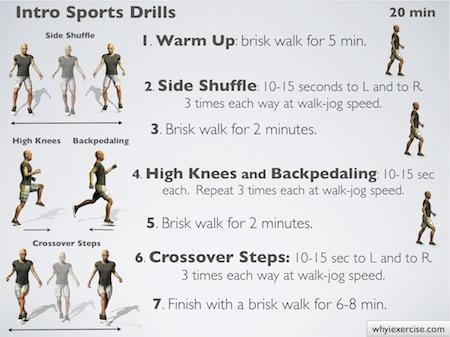In the bustling world of fitness, where trends rise and fall like the seasons, High-Intensity Interval Training (HIIT) has firmly established itself as a workout phenomenon. Promising quick results and maximum efficiency, HIIT is often hailed as the panacea for modern-day time constraints. But beneath the surface of its explosive popularity lies a pressing question: Is this adrenaline-pumping regimen truly suitable for everyone? As we delve into the heart of HIIT, exploring its origins, benefits, and potential pitfalls, we aim to uncover whether this vigorous approach to exercise can harmonize with the diverse tapestry of individual fitness levels and health conditions. Join us on this journey as we weigh the pros and cons of HIIT, seeking to illuminate its place in the vast landscape of personal well-being.
Understanding the Basics of High-Intensity Interval Training
High-Intensity Interval Training, commonly known as HIIT, is a workout strategy that alternates between short bursts of intense activity and periods of rest or low-intensity exercise. This approach not only boosts cardiovascular health but also enhances metabolic rate, making it a favorite among fitness enthusiasts. Key elements of HIIT include the intensity of the exercises and the duration of the rest intervals. By pushing your limits during the high-intensity phases and allowing for recovery in between, HIIT helps improve endurance and strength in a time-efficient manner.
For those new to HIIT, here are some fundamental aspects to consider:
- Intensity: Aim for exercises that elevate your heart rate significantly.
- Duration: Typically, the high-intensity phases last between 20 to 90 seconds.
- Rest Intervals: Balance the effort with adequate rest, ranging from 10 seconds to a full minute.
- Exercise Selection: Choose exercises that are scalable, like burpees, sprints, or jumping jacks.
Benefits: HIIT is celebrated for its ability to maximize calorie burn and improve cardiovascular health in a short period. Whether you’re a seasoned athlete or a beginner, understanding these basics can help tailor your HIIT routine to fit your fitness level and goals.

Evaluating the Health Benefits and Risks for Different Age Groups
High-Intensity Interval Training (HIIT) has surged in popularity due to its effectiveness and efficiency, but its suitability can vary across different age groups. Young adults often thrive on the adrenaline and vigorous nature of HIIT, benefiting from improved cardiovascular health, increased metabolism, and enhanced muscle tone. However, it’s crucial to ensure proper form and adequate recovery to prevent injuries. Middle-aged individuals might experience a resurgence of energy and improved fitness levels with HIIT, but they should be cautious of overexertion, particularly if they have pre-existing health conditions.
- Children and Teens: HIIT can be beneficial if tailored to their developmental stage, emphasizing fun and dynamic movements.
- Older Adults: With age-related concerns, modifications to intensity and duration are essential, focusing on maintaining joint health and balance.
Ultimately, the decision to incorporate HIIT should consider personal health status, fitness levels, and individual goals. Consulting with a healthcare provider or fitness professional can provide personalized guidance, ensuring that the benefits outweigh the potential risks.

Customizing Your HIIT Routine for Maximum Safety and Effectiveness
To ensure that your high-intensity interval training (HIIT) routine is both safe and effective, it’s crucial to tailor it to your individual needs and capabilities. Start by assessing your current fitness level and any pre-existing conditions that might affect your ability to perform certain exercises. Consulting with a fitness professional can provide valuable insights into designing a regimen that aligns with your health status. Remember, the key to successful HIIT lies in balancing intensity with appropriate rest periods, allowing your body to recover adequately between bursts of activity.
- Modify Exercises: Adapt movements to suit your body’s abilities, especially if you’re dealing with injuries or limitations.
- Monitor Intensity: Use heart rate monitors or perceived exertion scales to ensure you’re working within a safe intensity range.
- Prioritize Form: Correct form should always take precedence over speed or intensity to prevent injuries.
- Include Warm-ups and Cool-downs: These are essential to prepare your muscles for intense activity and aid in recovery.
- Listen to Your Body: Pay attention to signals of fatigue or pain and adjust your routine accordingly.
Incorporating these strategies into your HIIT sessions not only enhances safety but also maximizes the effectiveness of your workouts, helping you achieve your fitness goals more efficiently. Customization is the cornerstone of a sustainable and rewarding exercise experience, enabling you to push your limits while safeguarding your health.

Expert Recommendations for Integrating HIIT into Your Fitness Plan
For those looking to incorporate high-intensity interval training into their fitness regimen, expert insights can guide a seamless integration. First and foremost, it’s crucial to tailor the intensity and duration of your sessions to align with your current fitness level. Here are some key recommendations from fitness professionals:
- Start Gradually: Begin with shorter intervals and longer rest periods to allow your body to adapt to the new intensity.
- Focus on Form: Proper technique is essential to prevent injury, so prioritize mastering movements before increasing intensity.
- Mix It Up: Incorporate a variety of exercises to engage different muscle groups and prevent workout monotony.
- Listen to Your Body: Pay attention to any signs of overexertion and adjust your routine accordingly to ensure recovery and progress.
Experts also recommend consulting with a fitness professional, especially if you’re new to this form of exercise, to create a personalized plan that balances intensity with safety. By following these guidelines, you can effectively and safely integrate HIIT into your fitness journey.
In Summary
As we draw the curtain on our exploration of high-intensity interval training, it’s clear that this dynamic fitness trend is as multifaceted as the individuals who approach it. While HIIT offers a powerful punch of benefits, from time efficiency to cardiovascular improvements, it’s not a one-size-fits-all solution. The suitability of HIIT hinges on a delicate balance of personal health conditions, fitness levels, and individual preferences. For some, it may be the exhilarating path to peak fitness, while for others, a more moderate pace might be the key to sustainable well-being. Ultimately, the journey to fitness is deeply personal, and the best approach is one that aligns with your unique rhythm and goals. As you lace up your sneakers and step into the world of exercise, remember: the most important step is the one that gets you moving, in whatever way suits you best.

